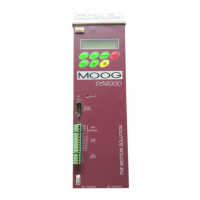SECTION FOUR – STARTING
DS2000 USER’S MANUAL (rev.C)
4.3
NOTE:
The display shows immediate information about motor and drive status by means of lighting:
• The display is lit with full light if no FAULTS are detected
• The display is lit with reduced intensity in case of FAULTS (refer to Section 6)
4.3 FIRST START-UP (ON TEST BENCH, FOR TESTING PURPOSES)
First, connect the power supply (both in case of 24 Volt and alternating voltage option).
Connect the feedback (resolver or encoder) and motor power cable, to also control the
motion.
Power the drive without giving the DRIVE ENABLE and the REFERENCE ENABLE.
The display must be lit, it is to say not in alarm condition; otherwise, check alarms in the
appropriate menu.
Hand-rotate the motor shaft in order to check the proper reading of feedback information by
the drive and eventually check the motor speed reading following the instructions contained
in the Display menu described in Section 6.
To control also motor motion, supply the three-phase alternating voltage and give the DRIVE
ENABLE and the REFERENCE ENABLE. It will be possible to move the motor with the given
settings if connections are not wrong.
If movements are missing, refer to Section 7 (Troubleshooting).
4.3.1 FEEDBACK CONNECTION (ENCODER OR RESOLVER)
Feedback connection must always be made according to the specification in section 2 even
if drive power supply is made only for testing purposes.
Inadequate connections (i.e.: unshielded cables) cause feedback and motor control errors.
4.3.2 “TEMPORARY” OR TEST POWER WIRING
In order to carry out a drive test, it is possible to supply the DS2000 with power in two ways:
• By a 24 VOLT, 1.5 A source
• By an alternating voltage (both single-phase and three-phase) between 120 and 510 V
ac
(if the drive is supplied with a voltage lower than 120V
ac
it is necessary to supply a 24
V
dc
auxiliary voltage, as the internal power supplier cannot properly work).
The 24 Volt solution allows a safe setting and testing the signal connections without
dangerous voltages.
NOTE: it is not possible to enable the output stages when DC BUS is not supplied with
power giving a DRIVE ENABLE signal, otherwise the drive will signal a DC BUS
UNDERVOLTAGE FAULT condition.
When drive is connected for test purposes only, it is possible to use a common, unshielded
cable, both for power input and to connect the motor power.

